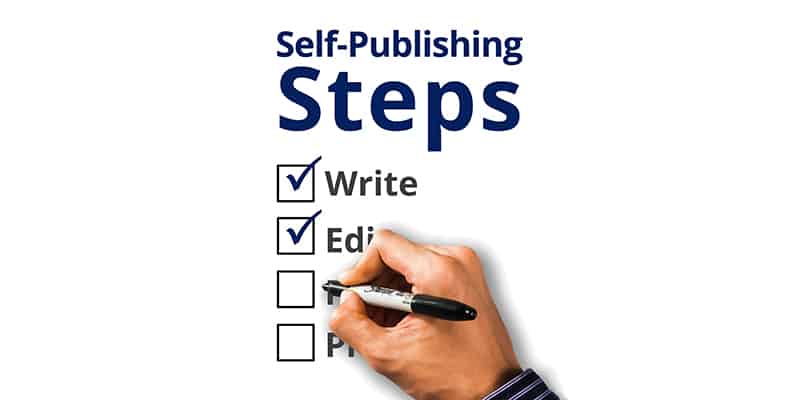
Self-publishing is intensive and overwhelming, but also rewarding. If you’re not sure is self-publishing is for you, check out our pros and cons list here. Otherwise, here are some straightforward steps on how to self publish a book to help you through this process!
Writing
- While writing, keep a separate file of back story and notes about your book’s world/magic/political situation, etc., so you can refer to it as you write your book. This keeps the story consistent, but doesn’t bore the reader with unnecessary details. Also keep a list of characters, their physical and emotional characteristics, relationships, quirks—anything that makes them stand out. Having this handy helps you keep eye color and mannerisms separate, and will be a time-saver while writing any sequels.
- After you finish writing your first draft, let the book rest for a week or two, and then come back with a fresh mind to rewrite it. At this step of the self-publishing process, you want to ask yourself several questions: Is there a crisis the character must face? Does each chapter end with a hook? Does the book have a strong climax? Have you dealt with all the loose ends? Are your characters and their actions believable? Are you consistent with point of view? Are you showing, not telling? Are you giving too much information that will bore the reader? Is the conclusion satisfying for your readers?
Beta Readers
- Send your book to at least two beta readers—readers who are willing to read your book and give you constructive feedback. Beta readers are usually free because they are paid with the ARC (Advanced Reader’s Copy) itself. Ask them to answer the same questions you asked yourself in the previous step. Plus ask them if there were any scenes they wished you’d included, or scenes that bored them or were awkward. Some authors use a dozen or more beta readers, but keep in mind if a beta reader is only finding a few typos and is NOT contributing to your rewriting, they may be better off as a reviewer instead. At this point you WANT to find things to fix. If you don’t have betas, consider employing a developmental editor to give you feedback instead.
- Rewrite your book again, incorporating the feedback from the beta readers.
- Read your book again, to make sure all the changes flow in smoothly, and to check grammar and punctuation. At this stage in the self-publishing process, it’s a great idea to use some Word macros to clean up your book.
Editing
- Send your book to at least two professional editors. “Professional” means that they have formal training in editing. This means that your relative who just likes to read does not count. Preferably, send your book to one editor, make the changes, then send your book to the second editor. Some editors will give you feedback on plot and others will only tell you about grammar issues. Ideally, you’d have at least one editor to give you feedback on plot and at least two for proofreading, but if you have great betas, you may feel that proofreading is all you need. Normally, a good proofreader will find 80% of the errors still in your book, which is why you need more than one.
- After using the editor changes, read your book again, using Microsoft Word’s Text to Speech feature to listen to your book while slowly reading. This will help you catch even more errors. For assistance on correct usage, check out our posts on grammar and punctuation.
Publishing
These next 5 self-publishing steps can be done by you, or you can hire a professional. Let’s take a look!
Cover Creation
- Create or commission a professional, eye-catching cover. A cover is one of the most important elements that sell a book, so if you don’t have experience (or time!), you’ll need to pay someone to create a cover for you. If you want to try your hand at cover design, check out our step-by-step guide on cover design here. Get feedback from friends and family on your cover and make changes to perfect it.
Print Book Creation
- If you want to create a print book, hire a typesetter to create it. Provide the typesetter the Word file and the cover image, and tell them what fonts were used on the cover (so they can use them in the book, for a consistent look) and what dimensions you want the book. A good typesetter will work with you to make sure you get the final product you want. Creating a professional-looking, print-ready file is something that requires a lot of training, so we recommend hiring a professional to format your self-published book.
Ebook Creation
- Create or commission an ebook for your book. A self-published author needs an ebook, because they do not have a publishing house getting their book into bookstores, or otherwise marketing their book. Readers are more willing to buy an ebook from an author they’ve never read before than they are willing to buy a print book. If you are creating your own ebook (which isn’t hard), we recommend using Jutoh; you can read more about different ebook creation software in our blog post here. For tips on how to create a professional-looking ebook, check out this blog post.
- Test your ebook on different ereaders to make sure it looks good.
Distribution
- Choose where you would like to distribute your book. Amazon’s KDP is a great option for distributing your print book on Amazon. For an overview of ebook vendors (many of which also sell print books) and how to distribute to them, check out our blog post here. At the very minimum, you should sell your book on Amazon, but we recommend selling on as many vendors as possible, so you can reach as many readers as possible. You can either distribute your books yourself (directly on the retailers or through aggregators), or you can pay a company to do it for you. We recommend doing it yourself.
- Make sure to fill out all book metadata on retailers and include an attention-grabbing, well-edited description.
Promotion
- Before your book is actually published, send out ARCs in return for reviews. That way, reviews can be posted right after your book is published, making your book more credible and attractive to other readers. Read this post for more ideas on how to get reviews for your book.
- Before your book is published, post about it on your website and let your readers know about it through your newsletter. If you don’t have many newsletter subscribers, you can use your website or subscriber magnets to find more subscribers.
- After your book is published, try out these 12 promotion strategies, which include temporarily discounting your ebook to reach more readers and make more sales, and then promoting that ebook through sites like Book Cave.
- Let readers know about your book through social media. For Facebook-specific strategies, check out our blog post here.
Keep doing the self-publishing steps!
- Keep writing, and start over at step one for your next book. The key to making money through self-publishing is to keep writing and publishing books. Once you have a few books published, promoting them and making more sales will be easier.
We hope these self-publishing steps will help you discover how to self publish a book. If you have any questions or comments, we’d love to hear them in the comments below!
















Great! This is very helpful Catia!
There are also a number of ways new authors can access professional services without breaking the bank.
Please read my blog: Top 10 Most Frequently Asked Questions About Self-Publishing
Hope this will also help, Thank you!